In the heart of dense rainforests and amidst the vibrant tapestry of nature, a remarkable creature dwells – the chimpanzee.
With their uncanny resemblances to humans and astonishing intelligence, these primates have captivated the imagination of people for centuries. As our closest living relatives in the animal kingdom, chimpanzees offer a unique glimpse into the evolutionary story that links us to our past.
In this article, we will delve into the captivating world of chimpanzees, separating fact from fiction, exploring their intricate behaviors, and uncovering the truths that make them both extraordinary and enigmatic. From their social dynamics to their cognitive prowess, join us on a journey to uncover the secrets of the chimpanzee and gain a deeper understanding of our own place in the natural world.

What is a Chimpanzee?
A chimpanzee, scientifically known as Pan troglodytes, is a highly intelligent and socially complex primate species belonging to the Hominidae family. These fascinating creatures share approximately 98% of their genetic material with humans, making them one of our closest living relatives.
Native to the dense forests and woodlands of Central and West Africa, chimpanzees are divided into four subspecies: the common chimpanzee (Pan troglodytes troglodytes), the Nigeria-Cameroon chimpanzee (Pan troglodytes ellioti), the western chimpanzee (Pan troglodytes verus), and the eastern chimpanzee (Pan troglodytes schweinfurthii).
Throughout history, chimpanzees have been subjects of study and intrigue, offering insights into our evolutionary history and shedding light on the intricacies of primate behavior.
Appearance
What does the chimpanzee look like?
Chimpanzees possess a robust and muscular build, with a relatively compact and sturdy stature.
Covered in coarse black hair, chimpanzees’ bodies are endowed with a natural safeguard against environmental elements. The hair’s hue might appear deeper on their torsos, while it can adopt a lighter shade on their facial and limb areas.
Apart from their hair, chimpanzees feature patches of exposed skin on their faces, palms, and the soles of their feet. These regions of bare skin may vary in color, ranging from hues of pink to brown.
Chimpanzee facial characteristics exhibit a fusion of human and ape attributes. The notable presence of a brow ridge imparts a projecting aspect to their countenance. Their eyes are profoundly expressive, capable of conveying a wide spectrum of emotions through a rich repertoire of facial expressions.
The structure of their hands and feet contributes to their adaptability. Endowed with opposable thumbs and elongated fingers, chimpanzees can adeptly manipulate objects. Furthermore, their feet serve dual functions, supporting both gripping and walking abilities, which facilitate both quadrupedal (using all four limbs) and bipedal (walking on two legs) locomotion.
Similar to human ears in structure, chimpanzees’ ears adorn their heads. Their noses are flat and protruding, completing the ensemble of their distinctive facial features.
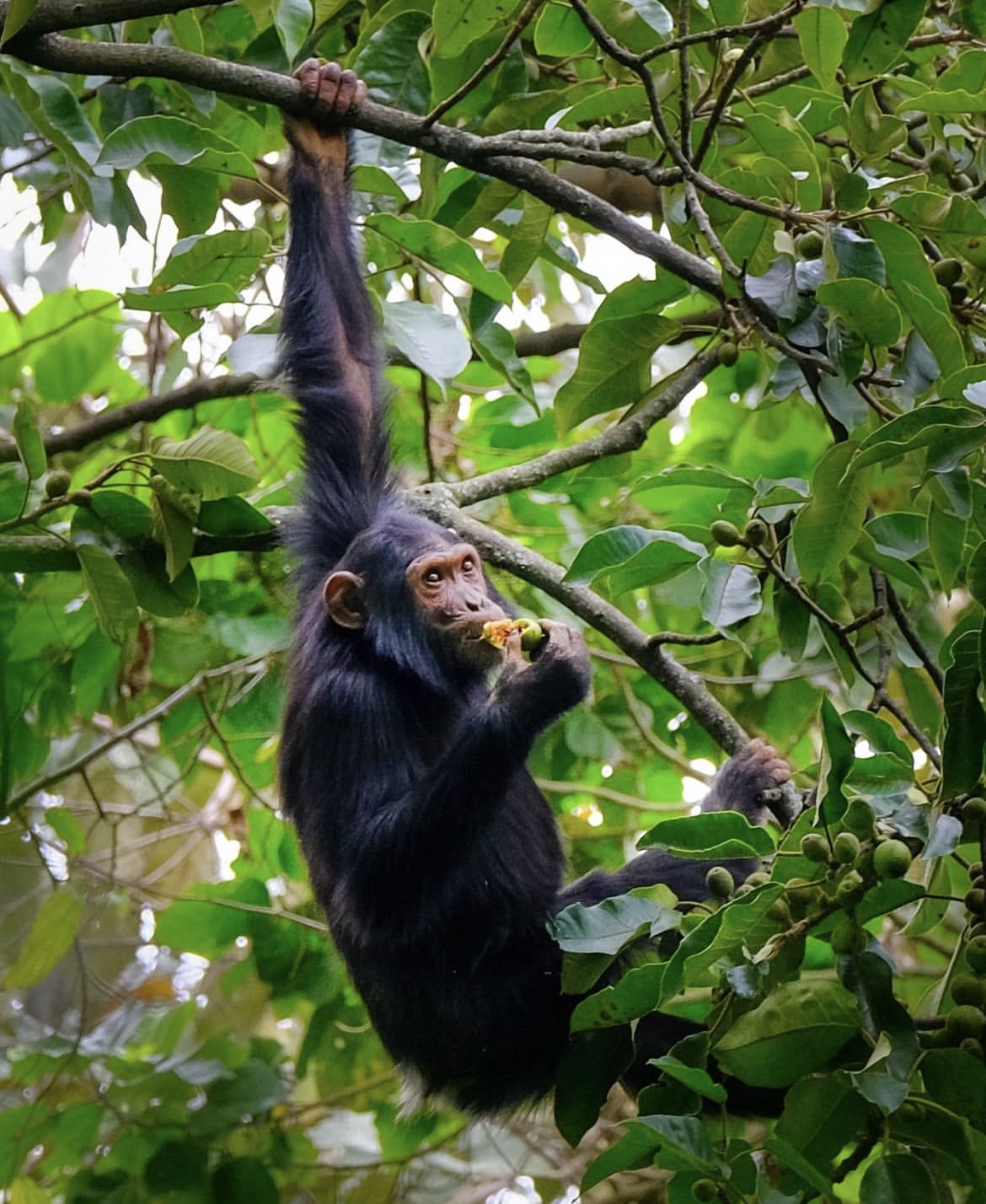
How big are chimpanzees?
Chimpanzees exhibit sexual dimorphism, meaning there are distinct size differences between males and females:
Males – Adult male chimpanzees are larger and more robust than females. On average, they stand around 3.3 to 5.6 feet (1 to 1.7 meters) tall when standing upright on two legs. Their weight can range from 90 to 120 pounds (40 to 55 kilograms).
Females – They have an average height ranging from 2.3 to 4.9 feet (0.7 to 1.5 meters) when standing upright, while their weight typically falls between 70 to 100 pounds (32 to 45 kilograms).
These size differences are reflective of the social and reproductive dynamics within chimpanzee communities, where males often compete for dominance and access to females. The physical variations between males and females play a role in their social interactions and behaviors.

Behaviour
Chimpanzee behavior is a captivating blend of social complexity, problem-solving skills, and intricate communication.
Living in tight-knit communities, chimpanzees display a dynamic range of interactions, from nurturing friendships and forming alliances to asserting dominance and resolving conflicts. Their ability to use tools, such as sticks for extracting termites or rocks for cracking nuts, showcases their intelligence and capacity for tool manipulation.
Chimpanzees are known to engage in playful activities, like wrestling and chasing, which help strengthen social bonds and diffuse tension. Their communication is multifaceted, involving a mix of vocalizations, gestures, and facial expressions that convey emotions, intentions, and warnings. The intricate tapestry of chimpanzee behavior offers a window into the rich complexities of their societies and provides insights into the origins of human social traits.
What do chimpanzees eat?
Chimpanzees, being omnivorous, display a diverse diet encompassing both plant-based and animal-based foods. Their eating habits are influenced by factors like location, habitat, and food availability. Their dietary preferences include:
Fruits: Fruits form a substantial part of chimpanzee nutrition, comprising an assortment of options like berries, figs, and tropical fruits. Their selective nature leads them to favor ripe fruits due to enhanced nutritional value and flavor.
Vegetation: Alongside fruits, chimpanzees consume leaves, flowers, and other plant components, which provide essential nutrients like fiber, vitamins, and minerals.
Nuts and Seeds: Chimpanzees may utilize tools like sticks or rocks to crack open hard-shelled nuts and access the nutrient-rich kernels within, contingent on their surroundings.
Insects: Insects such as ants, termites, and beetles contribute a valuable protein source to their diet. Ingenious tool use, like sticks or leaves, helps them extract insects from crevices or nests.
Meat: While not their primary food source, chimpanzees exhibit opportunistic hunting and scavenging tendencies, occasionally consuming small mammals like monkeys and even engaging in cannibalism in specific instances.
Honey: Chimpanzees have been documented seeking out beehives to obtain honey, a high-calorie and sweet dietary addition.
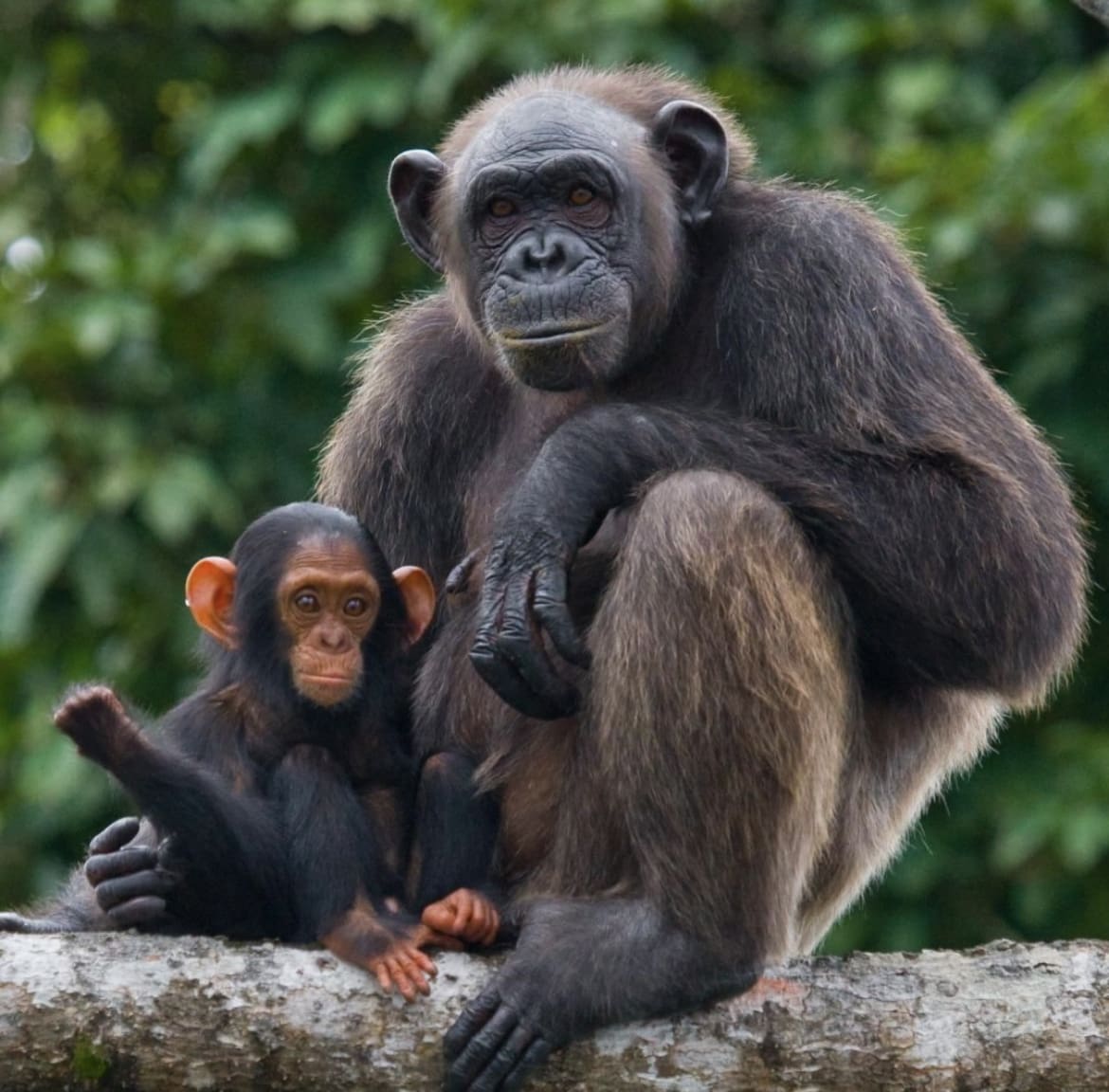
How do chimpanzees reproduce?
Chimpanzee reproduction encompasses several stages, each vital to the survival of the species. Here’s a comprehensive overview of the chimpanzee reproductive process:
Mating among chimpanzees does not adhere to a specific breeding season, and females do not strictly follow an estrus cycle. Instead, females exhibit subtle physical and behavioral changes when they are receptive to mating. Males within a chimpanzee community engage in competition for dominance and access to females. Dominant males often secure more opportunities for mating, although females may also mate with multiple males.
The gestation period for chimpanzees spans approximately 230 to 240 days, translating to about 7.5 to 8 months. During pregnancy, female chimpanzees maintain their usual activities, including foraging and social interactions, as they carry their developing offspring.
Chimpanzee births usually result in the arrival of a single infant. The birthing process can occur both during daylight hours and at night. Mothers typically give birth in secluded areas, adopting a standing or squatting posture during labor. Newborn chimpanzees are comparatively small, weighing approximately 2.2 to 4.4 pounds (1 to 2 kilograms).
Chimpanzee mothers demonstrate exceptional attentiveness to their infants. Newborns possess a strong grip that facilitates clinging to their mother’s fur. In their early months of life, infants are carried on their mother’s belly or back. They rely on their mother for nourishment, protection, and crucial socialization. The mother-infant bond is of paramount importance for the infant’s overall development and survival.
As chimpanzee infants grow, they gradually transition from nursing to consuming solid foods. This weaning process typically occurs between 3 to 5 years of age. As they explore their environment, young chimpanzees learn about available food sources. Their increasing independence becomes evident, although many maintain close relationships with both their mothers and fellow community members.
Sexual maturity in chimpanzees varies by gender. Females generally attain sexual maturity between the ages of 10 to 12 years, while males experience this milestone a bit later, around 13 to 15 years. This timing can be influenced by factors such as genetics, social interactions, and food availability.
The intricate reproductive and parenting behaviors of chimpanzees are deeply entwined with the complex social dynamics within their communities. Female chimpanzees often receive support from their fellow group members, with older siblings and other community members contributing to the care of young infants. This collaborative approach to parenting exemplifies the intricate relationships and social bonds that define chimpanzee societies.
Do chimpanzees fight?
Chimpanzee social groups embody a mix of natural aggression and intricate dynamics. Conflict, arising from territorial defense, dominance hierarchies, male competition, resource scarcity, and even infanticide, interweaves with their complex social fabric. These behaviors underline their primal instincts and evolutionary adaptations.
Territorial Aggression emerges as a pivotal theme, involving vocalizations, displays, and confrontations when rival groups’ territories intersect. Dominance Hierarchies, central to their communities, lead to clashes as lower-ranking individuals strive to climb the social ladder.
Male-Male Competition intensifies the narrative, manifesting in dominance battles and mating access struggles. Resource Competition follows, sparking confrontations to secure food and vital resources. Infanticide, though darker, reveals a strategic aspect, driven by external males aiming to expedite mating opportunities.
However, aggression isn’t the sole focus. Conflict Resolution, including grooming and reconciliation, serves as a vital counterbalance, emphasizing social harmony. In the grand tapestry of chimpanzee life, aggression and cooperation intertwine, shaping their intricate social landscape.
Habitat & Range
Where do chimpanzees live?
Chimpanzees are native to several countries in central and western Africa. They inhabit a variety of forested and woodland habitats, including rainforests, savannas, and montane forests. Some of the countries where chimpanzees are found include:
Uganda: Chimpanzees can be found in national parks such as Kibale National Park and Budongo Forest.
Tanzania: Gombe Stream National Park and Mahale Mountains National Park are known for their chimpanzee populations.
Democratic Republic of Congo: Virunga National Park and Kahuzi-Biega National Park are home to chimpanzee communities.
Rwanda: Nyungwe Forest National Park is a habitat for chimpanzees in Rwanda.
Cameroon: Chimpanzees are found in various forested areas, including the Campo Ma’an National Park.
Nigeria: Cross River National Park and Gashaka Gumti National Park are among the locations where chimpanzees reside.
Ivory Coast (Côte d’Ivoire): Tai National Park is a UNESCO World Heritage Site known for its chimpanzee population.
Gabon: Loango National Park and Moukalaba-Doudou National Park are some of the places where chimpanzees can be found.
Senegal: In the western part of their range, chimpanzees inhabit the Taï National Park.
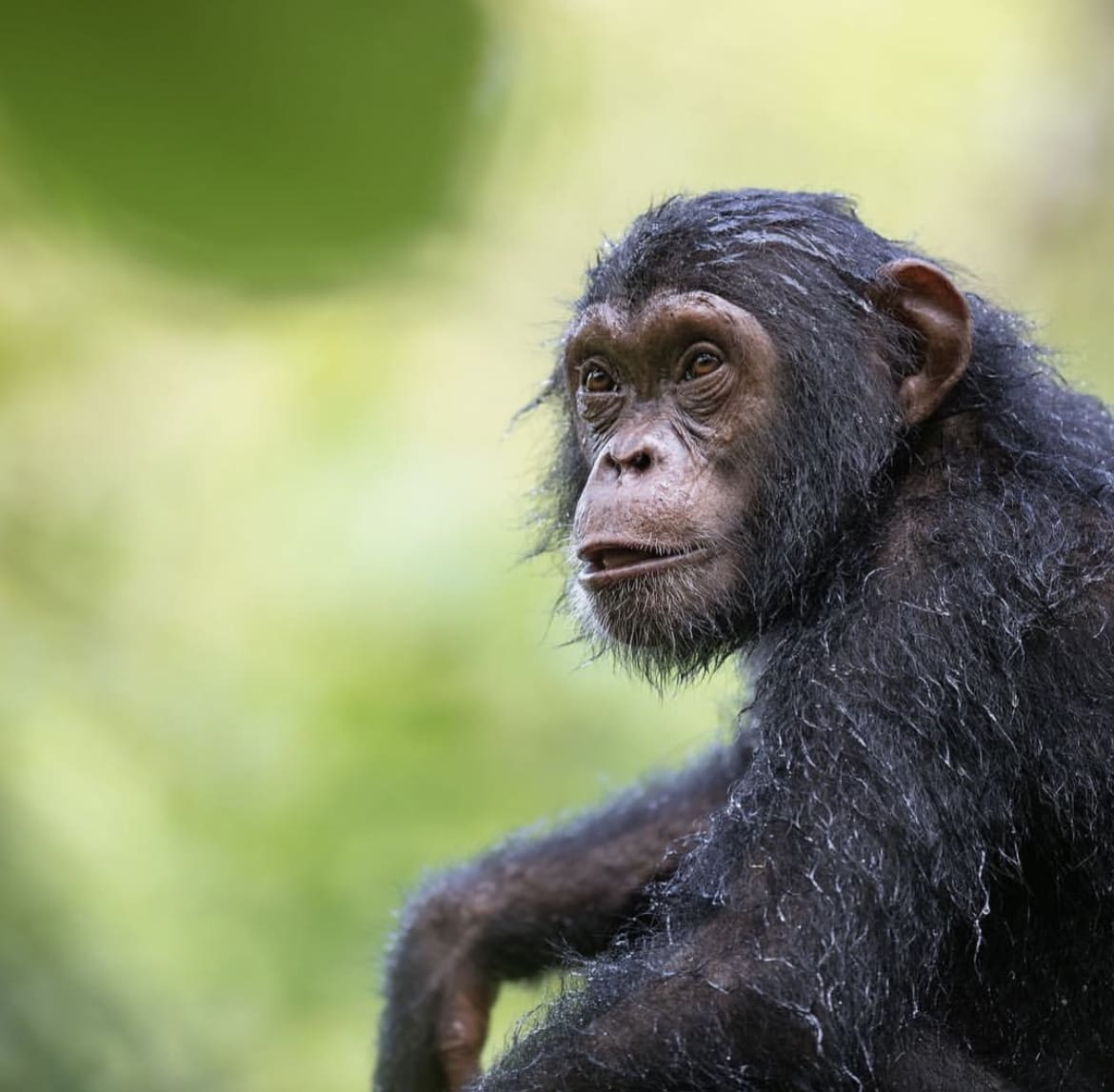
Conservation
Are chimpanzees endangered?
Chimpanzees are considered endangered. Their populations have been declining over the years due to a combination of factors, including habitat loss, poaching, disease, and human-wildlife conflict.
How many chimpanzees are there in the wild?
Estimates of the exact number of chimpanzees in the wild can vary and are often challenging to determine accurately. However, the International Union for Conservation of Nature (IUCN) estimated the total wild chimpanzee population to be between 172,000 and 299,000 individuals across their entire range in Africa.
What are the major threats facing chimpanzees?
Chimpanzees face severe threats due to human activities and environmental changes, leading to their endangered status.
These threats include habitat loss from deforestation and urbanization, poaching for bushmeat, diseases like Ebola, human-wildlife conflict, climate change affecting food sources, infrastructure development, illegal wildlife trade, and insufficient awareness and enforcement. Addressing these challenges requires collaborative efforts involving governments, conservation groups, communities, and international initiatives.
Conservation strategies encompass habitat preservation, anti-poaching measures, education, sustainable practices, and research for effective protection.
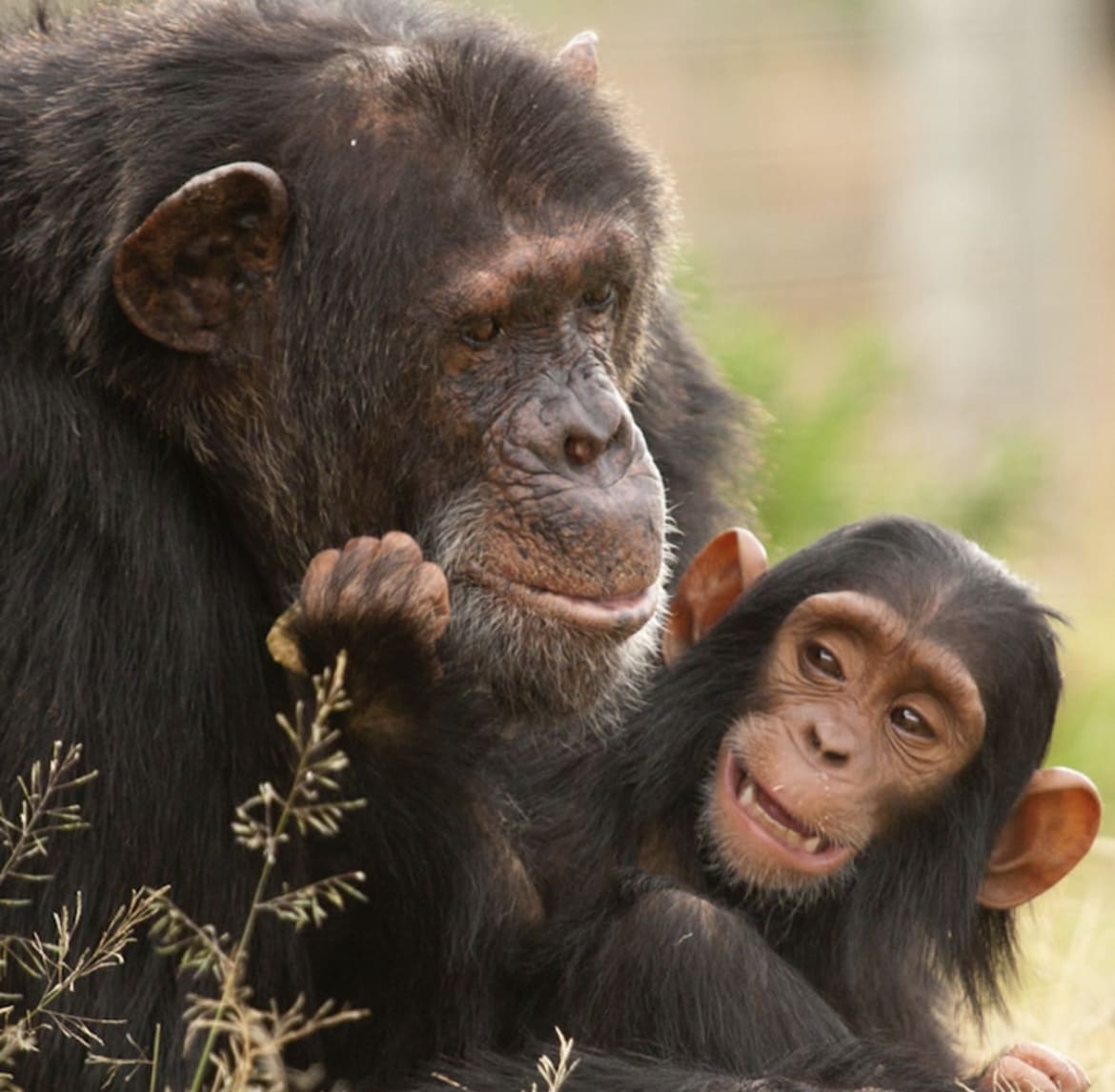
Safari
Where is the best place to see chimpanzees in the wild?
Kibale National Park, Uganda: Kibale is known as the “Primate Capital of the World” and offers one of the best opportunities to see chimpanzees in their natural habitat. The park has a large population of chimps, and guided trekking tours are available to increase your chances of encountering them.
Mahale Mountains National Park, Tanzania: Located on the shores of Lake Tanganyika, Mahale Mountains National Park is home to a significant population of chimpanzees. This remote park offers a unique opportunity to observe chimpanzees in a stunning lakeside setting.
Nyungwe Forest National Park, Rwanda: While Rwanda is famous for its mountain gorillas, Nyungwe Forest National Park also hosts a population of chimpanzees. Guided trekking tours provide the chance to see these primates along with other wildlife.
Boabeng-Fiema Monkey Sanctuary, Ghana: This sanctuary in Ghana is home to both mona monkeys and the rare colobus monkeys, as well as a population of chimpanzees. It offers a more accessible option for those interested in chimpanzee and primate sightings.
Odzala-Kokoua National Park, Republic of Congo: This park is home to a population of Western chimpanzees and offers a remote and adventurous opportunity to see chimpanzees in a pristine rainforest environment.
Gashaka Gumti National Park, Nigeria: This Nigerian national park is home to a diverse range of wildlife, including chimpanzees. It provides a chance to see these primates in the unique context of Nigeria’s natural landscapes.
Tips for spotting chimpanzees while on safari
Spotting chimpanzees in the wild can be an exciting and rewarding experience, but it requires patience, preparation, and understanding their behaviour. Here are some tips to increase your chances of seeing chimpanzees:
1. Guided Tours: Joining guided tours led by experienced local guides and park rangers is the best way to increase your chances of spotting chimpanzees. These guides are familiar with the chimps’ habitats, behaviour, and likely locations.
2. Choose the Right Season: Research the best time to visit the specific park or reserve you’re interested in. Dry seasons often make it easier to spot chimpanzees as they are more likely to be near water sources and less hidden by dense foliage.
3. Early Mornings: Chimpanzees are most active during the early morning hours. Plan to start your trekking early to catch them while they are feeding and moving around.
4. Be Quiet and Respectful: While trekking, maintain a quiet and respectful demeanour. Loud noises or sudden movements can startle chimpanzees and cause them to retreat deeper into the forest.
5. Follow Guide’s Instructions: Follow your guide’s instructions closely. They have valuable knowledge about chimpanzee behavior and can identify signs such as vocalizations, tracks, or nests that indicate their presence.
6. Stay at a Respectful Distance: When you encounter chimpanzees, maintain a respectful distance to minimize stress and disturbance. Most parks have guidelines specifying the minimum distance to keep from the animals.
7. Be Patient: Chimpanzee sightings are not guaranteed. Be prepared for the possibility that you may not encounter them on your first attempt. Patience is key.
8. Use Binoculars: Bring a good pair of binoculars to help you spot chimpanzees high in the trees or at a distance.
9. Wear Appropriate Clothing: Wear neutral-colored, comfortable clothing that blends in with the environment. Avoid bright colors that might alarm the chimpanzees.
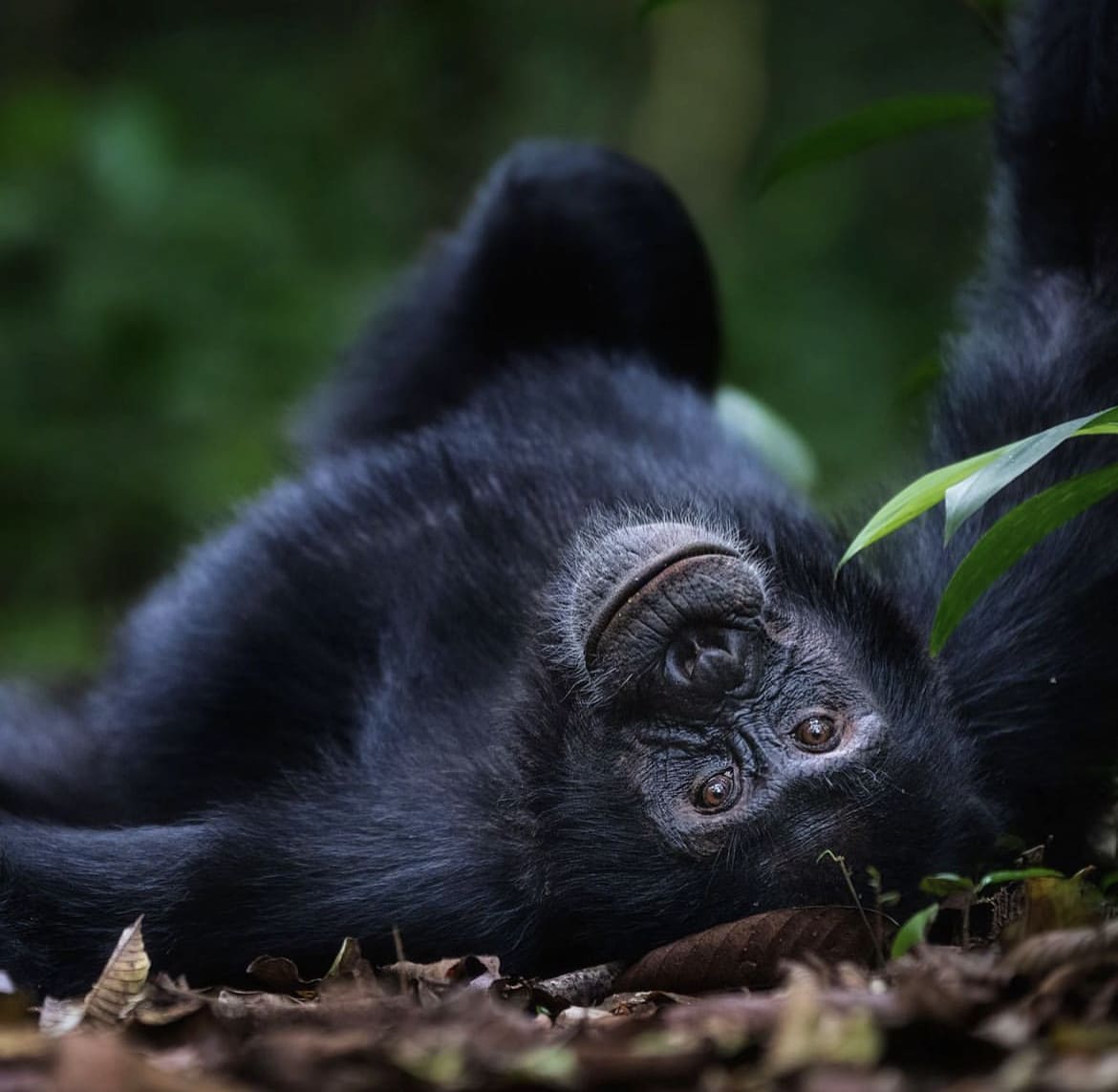
Facts about chimpanzees
Closest Living Relatives: Chimpanzees are one of the closest living relatives to humans, sharing about 98-99% of their DNA with us.
Social Structure: Chimpanzees live in complex social groups called communities, consisting of multiple individuals. These communities exhibit hierarchies, alliances, and social bonds.
Tool Use: Chimpanzees are known for their advanced tool-using abilities. They use sticks, leaves, and other objects as tools for tasks like termite fishing, ant dipping, and cracking nuts.
Communication: Chimpanzees communicate using a combination of vocalizations, gestures, and facial expressions. They can express emotions such as happiness, fear, and anger through their calls and body language.
Problem-Solving Skills: Chimpanzees have demonstrated impressive problem-solving skills, such as using sticks to retrieve insects from tree bark or creating makeshift tools to access hard-to-reach food.
Cultural Differences: Different chimpanzee communities can exhibit variations in behaviors and tool use, which can be considered cultural differences. This suggests the transmission of learned behaviors within specific groups.
Diet Diversity: Chimpanzees are omnivorous and have a varied diet that includes fruits, leaves, insects, nuts, and sometimes small mammals. Their dietary flexibility contributes to their adaptability.
Long Lifespan: In the wild, chimpanzees have an average lifespan of around 40 to 50 years. In captivity, they can live even longer, reaching ages of over 60 years.
Empathy and Cooperation: Chimpanzees display empathy and cooperation, helping and comforting each other in times of distress. They can also work together to achieve common goals.
Male Bonding: Male chimpanzees form strong bonds with each other, engaging in activities like grooming, playing, and patrolling their territory together.
Self-Awareness: Chimpanzees have shown signs of self-awareness in mirror tests, indicating a level of self-recognition and cognitive complexity.
Hunting and Meat Consumption: In some chimpanzee communities, males engage in organized hunting of small mammals, such as monkeys. This behavior is not seen in all populations.

Myths about chimpanzees
Chimpanzees Are Always Friendly: While chimpanzees do engage in social behaviors and form strong bonds, they can also be aggressive and exhibit violent behaviors, especially during conflicts or dominance struggles.
Chimpanzees Are Suitable Pets: Chimpanzees are not suitable as pets. Their complex social and psychological needs cannot be adequately met in a human home environment. Keeping them as pets often results in behavioral issues and poses risks to both the animals and humans.
Chimpanzees Don’t Feel Pain or Emotions: Chimpanzees are sentient beings capable of feeling pain, emotions, and even exhibiting empathy. They can experience joy, sadness, fear, and stress, just like other animals.
Chimpanzees Can Easily Adapt to Captivity: Chimpanzees that have lived in the wild cannot easily adapt to captivity. Captive chimpanzees often face physical and psychological challenges, and attempts to reintroduce them to the wild are complex and require careful planning.
